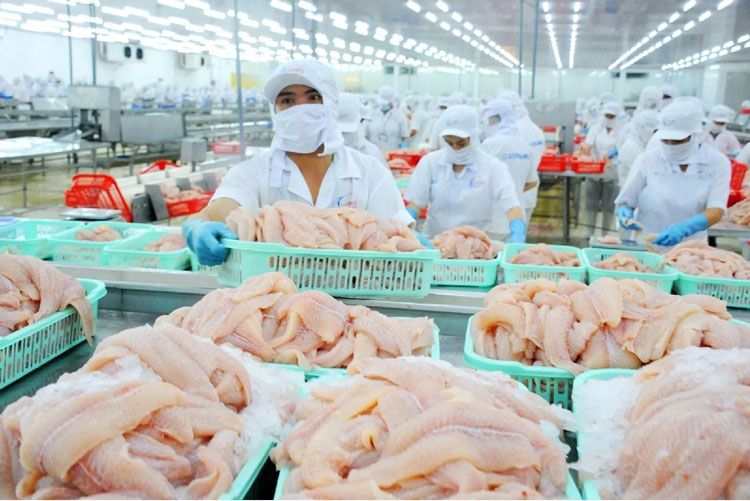According to the Vietnam Association of Seafood Exporters and Producers (VASEP), in July, exports of all key products grew better. Of which, shrimp exports increased by 11%, the highest in the first 7 months of the year. The Chinese and EU markets increased by 24% and 32% respectively, while exports to the US increased by 9% and Japan by 4%.
In the first 7 months of 2024, shrimp exports reached nearly 2 billion USD, up 7% over the same period last year. Of which, white-leg shrimp reached 1.45 billion USD, up 4%, black tiger shrimp reached 246 million USD, down 10%. Lobster exports alone increased nearly 3 times to 145 million USD.
Pangasius exports grew by 23% in July. Exports to all major markets grew by double digits, from 20-40%, except for the EU market, which increased by 5%. In the first 7 months of the year, pangasius exports reached nearly 1.09 billion USD, up 7.7% over the same period last year. China is still the number 1 market for Vietnamese pangasius, with a value of 317 million USD.
According to VASEP, the Chinese market mainly consumes large-sized pangasius over 1.2 kg/fish in whole or fillet form. In addition, this is also a potential market for by-products such as pangasius maw. In the first 7 months of this year, pangasius maw exports reached about 50 million USD, of which exports to the Chinese market alone reached 40 million USD, accounting for 80%.
Regarding tuna exports, after continuous double-digit growth of 16-32%, July exports slowed down, increasing only 9% compared to the same period last year. In the first 7 months of the year, tuna exports reached 555 million USD, up 21% compared to the same period last year. Of which, the 2 main export product lines are canned tuna, bagged tuna and frozen tuna loin/fillet (also the raw material for canned fish production).

Seafood exports in the first seven months of the year reached 5.28 billion USD, up 7% over the same period in 2023. Of which, the 4 markets with the highest growth value were China 30%, the US 14%, Japan 11% and the EU 14%.
VASEP believes that since Decree 37/2024 took effect (from May 19, 2024), tuna processing and exporting enterprises have fallen into a "tired" situation because they cannot buy canned tuna raw materials according to the new regulations requiring that exploited skipjack tuna must have a minimum size of 0.5m.
After more than 2 months since Decree 37 took effect, some tuna businesses have completely stopped purchasing domestically exploited striped fish from fishermen because they cannot ensure 100% of the size is 0.5 meters or more.
Most fishing ports have now stopped certifying raw materials (S/C papers) for skipjack tuna shipments due to the size of the exploited fish being smaller than the regulations of Decree 37. Meanwhile, this period is the 3-month peak season (July, August, September) for skipjack tuna exploitation by fishermen.
Currently, VASEP has sent an official dispatch to the Prime Minister and the Minister of Agriculture and Rural Development reporting on the proposal to amend Decree 37 to be consistent with international practices and reality, including the content related to the regulation on minimum size of skipjack tuna. At the same time, VASEP also sent an official dispatch to member enterprises requesting compliance with IUU regulations and regulations in Decree 37 while waiting for the Government to review and amend.
In addition to tuna, other seafood products such as squid, octopus and other marine fish are also in a state of shortage of raw materials for export, and raw materials for export to the EU have not been certified. In addition, exports of other marine fish (except tuna) also decreased by more than 4% in the first 7 months of this year. Meanwhile, squid and octopus exports were only equivalent to the same period in 2023, reaching about 351 million USD.
In terms of markets, China, the US, Japan and the EU 14% are the markets with the highest growth value, increasing by 30%, 14%, 11% and 14% respectively. In the first 7 months of 2024, seafood exports to the US and China both increased by 10% and accounted for an equal proportion, nearly 18% of Vietnam's total seafood exports, reaching over 930 million USD. Exports to the EU also increased by 10% to over 600 million USD. Exports to South Korea increased slightly by 1%, reaching 426 million USD.
According to VASEP, positive signals such as economic recovery, lower inflation, and lower interest rates may stimulate demand in the US and EU markets for frozen seafood products. Meanwhile, frozen product exports to China have not yet made a breakthrough due to relatively low prices.
On the contrary, China is the largest market for fresh seafood products serving restaurants, hotels, and tourism . Therefore, fresh products such as lobster, crab, clam, snail... will still attract Chinese customers in the near future.
Source: https://danviet.vn/xuat-khau-thuy-san-hon-52-ty-usd-trung-quoc-tang-mua-30-mot-bo-phan-cua-loai-ca-nay-mang-ve-50-trieu-usd-20240805111629618.htm


![[Photo] Readers line up to visit the photo exhibition and receive a special publication commemorating the 135th birthday of President Ho Chi Minh at Nhan Dan Newspaper](https://vphoto.vietnam.vn/thumb/1200x675/vietnam/resource/IMAGE/2025/5/17/85b3197fc6bd43e6a9ee4db15101005b)



![[Photo] More than 17,000 candidates participate in the 2025 SPT Competency Assessment Test of Hanoi National University of Education](https://vphoto.vietnam.vn/thumb/1200x675/vietnam/resource/IMAGE/2025/5/17/e538d9a1636c407cbb211b314e6303fd)
![[Photo] Prime Minister Pham Minh Chinh chairs meeting on science and technology development](https://vphoto.vietnam.vn/thumb/1200x675/vietnam/resource/IMAGE/2025/5/17/ae80dd74c384439789b12013c738a045)





























![[Photo] Nearly 3,000 students moved by stories about soldiers](https://vphoto.vietnam.vn/thumb/1200x675/vietnam/resource/IMAGE/2025/5/17/21da57c8241e42438b423eaa37215e0e)




































































Comment (0)